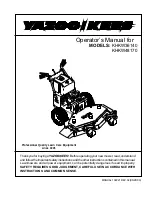
8
STOPPING THE ENGINE
1. PDA, SDA: Move the throttle lever to
the SLOW position.
2. SDA: Release the
clutch lever.
VKA: Release the
Smart Drive control
lever.
3. Release the blade control lever.
4. When the mower is not in use,
turn the fuel valve OFF.
SAFE MOWING PRACTICES
For your safety, keep all four wheels on the ground, and be careful to
avoid losing your footing and your control of the mower. Keep a firm
grip on the handlebar, and walk, never run, with the mower. Be very
careful when mowing uneven or rough ground.
If stuck, do not kick or shove the mower with your foot. Use the
handlebar to control the mower.
Slopes
Mow across slopes, not up and down.
Avoid steep slopes (more than 20
°
),
and be careful when changing direction.
Mowing on a slope when the grass is
damp or wet could cause you to slip,
fall, and lose control of the mower.
Obstacles
Use the side of the mower to cut close
to large obstacles, such as fences or
walls.
Release the clutch lever or the Smart Drive control to disengage the
drive when mowing around trees and other obstacles. Push the
mower around obstacles for better directional control. Be careful when
mowing over obstacles embedded in the lawn, such as sprinkler
heads, paving, edging, raised tree roots, etc. Avoid anything that
sticks up above the surface of the lawn.
If the blade hits something, or if the mower starts to vibrate, stop the
engine immediately, disconnect the spark plug cap, and check for
damage (page 10). Striking objects may damage the blade(s), bend
the crankshaft, and/or break the mower deck or other components.
Vibration usually indicates serious trouble.
The
DISTRIBUTOR’S LIMITED WARRANTY
cover parts damaged by collision.
Gravel and Loose Objects
Gravel, loose stones, and landscaping material can be picked up by
the mower and thrown many feet with enough force to cause serious
personal injury and/or property damage. The best way to prevent
potential injury from thrown objects is to release the blade control
lever to stop the blade(s) before reaching areas with gravel, loose
stones, or landscaping material.
MOWING TIPS
Which Blade?
Grasses and lawn conditions vary greatly, so Honda models can use
a number of standard and optional blades. Use this chart to help
determine which blade(s) are best suited for your lawn. See page 19
for more information on these blades.
*Always use an upper and lower blade on the HRR.
B
WARNING
The blade(s) are sharp and spin at high speed. A spinning
blade can cut you severely and can amputate fingers and
toes.
• Wear protective footwear.
• Keep your hands and feet away from the mower deck while
the engine is running.
• Stop the engine before performing any adjustment,
inspection, or maintenance.
SLOW
CLUTCH LEVER
(SDA
SHOWN)
BLADE CONTROL
LEVER
(PDA)
(VKA)
OFF
FUEL
VALVE
B
WARNING
A worn, cracked, or damaged blade can break, and pieces
of the damaged blade can become dangerous projectiles.
Thrown objects can cause serious injury.
Inspect the blade(s) regularly, and do not operate the mower
with a worn or damaged blade.
Model
Performance
Blade(s)
Mulching Bagging
Side
Discharge
HRS
Good
Good
Good
Standard low-lift single
Best
Best
Best
Optional upper mulching Optional
high-lift lower
HRR*
Best
Best
Best
Standard upper mulching
Standard high-lift lower
Summary of Contents for 00X31-VL0-U540
Page 22: ...NOTES...









































